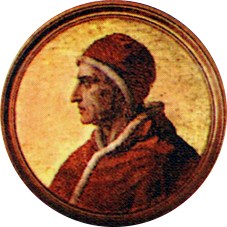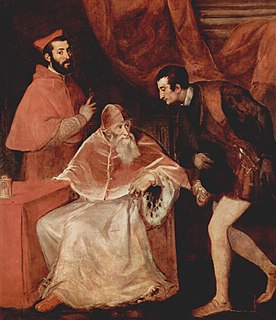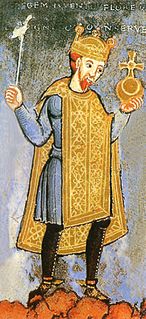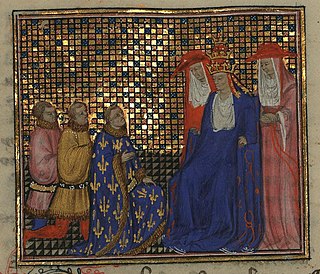Related Research Articles
An antipope is a person who, in opposition to the lawful pope, makes a significant attempt to occupy the position of Bishop of Rome and leader of the Catholic Church. At times between the 3rd and mid-15th centuries, antipopes were supported by important factions within the Church itself and by secular rulers.

Baldassarre Cossa was Pisan antipope John XXIII (1410–1415) during the Western Schism. The Catholic Church regards him as an antipope, as he opposed Pope Gregory XII whom the Catholic Church now recognizes as the rightful successor of Saint Peter.

The Council of Constance was a 15th-century ecumenical council recognized by the Catholic Church, held from 1414 to 1418 in the Bishopric of Constance in present-day Germany. The council ended the Western Schism by deposing or accepting the resignation of the remaining papal claimants and by electing Pope Martin V.
The history of Christianity concerns the Christian religion, Christendom, and the Church with its various denominations, from the 1st century to the present.

Pope Gregory XI was Pope from 30 December 1370 to his death in 1378. He was the seventh and last Avignon pope and the most recent French pope. In 1377, Gregory XI returned the Papal court to Rome, ending nearly 70 years of papal residency in Avignon, France. His death shortly after was followed by the Western Schism involving two Avignon-based antipopes.

Pope Gregory XII, born Angelo Corraro, Corario, or Correr, was Pope of the Catholic Church from 30 November 1406 to 4 July 1415 when he was forced to resign to end the Western Schism. He succeeded Pope Innocent VII and in turn was succeeded by Pope Martin V.

The Avignon Papacy, also known as the Babylonian Captivity, was the period from 1309 to 1376 during which seven successive popes resided in Avignon rather than in Rome. The situation arose from the conflict between the papacy and the French crown, culminating in the death of Pope Boniface VIII after his arrest and maltreatment by Philip IV of France. Following the further death of Pope Benedict XI, Philip forced a deadlocked conclave to elect the French Clement V as pope in 1305. Clement refused to move to Rome, and in 1309 he moved his court to the papal enclave at Avignon, where it remained for the next 67 years. This absence from Rome is sometimes referred to as the "Babylonian captivity of the Papacy".

Pope Paul IV, C.R., born Gian Pietro Carafa, was head of the Catholic Church and ruler of the Papal States from 23 May 1555 to his death in 1559. While serving as papal nuncio in Spain, he developed an anti-Spanish outlook that later coloured his papacy. A part of the Papal States was invaded by Spain during his papacy and in response to this, he called for a French military intervention. To avoid a conflict at the same time of the Italian War of 1551–1559, the Papacy and Spain reached a compromise with the Treaty of Cave: French and Spanish forces left the Papal States and the Pope adopted a neutral stance between France and Spain.

Restorationism is the belief that Christianity has been or should be restored along the lines of what is known about the apostolic early church, which restorationists see as the search for a purer and more ancient form of the religion. Fundamentally, "this vision seeks to correct faults or deficiencies by appealing to the primitive church as a normative model."
The Gregorian Reforms were a series of reforms initiated by Pope Gregory VII and the circle he formed in the papal curia, c. 1050–80, which dealt with the moral integrity and independence of the clergy. The reforms are considered to be named after Pope Gregory VII (1073–85), though he personally denied it and claimed his reforms, like his regnal name, honoured Pope Gregory I.

The Western Schism, also called Papal Schism, Great Occidental Schism and Schism of 1378, was a split within the Catholic Church lasting from 1378 to 1417 in which two men simultaneously claimed to be the true pope, and each excommunicated one another. Driven by authoritative politics rather than any theological disagreement, the schism was ended by the Council of Constance (1414–1418). For a time these rival claims to the papal throne damaged the reputation of the office.
Conciliarism was a reform movement in the 14th-, 15th- and 16th-century Catholic Church which held that supreme authority in the Church resided with an Ecumenical council, apart from, or even against, the pope. The movement emerged in response to the Western Schism between rival popes in Rome and Avignon. The schism inspired the summoning of the Council of Pisa (1409), which failed to end the schism, and the Council of Constance (1414–1418), which succeeded and proclaimed its own superiority over the Pope. Conciliarism reached its apex with the Council of Basel (1431–1449), which ultimately fell apart. The eventual victor in the conflict was the institution of the Papacy, confirmed by the condemnation of conciliarism at the Fifth Lateran Council, 1512–17. The final gesture however, the doctrine of Papal Infallibility, was not promulgated until the First Vatican Council of 1870.

Pedro Martínez de Luna y Pérez de Gotor, known as el Papa Luna in Spanish and Pope Luna in English, was an Aragonese nobleman, who as Benedict XIII, is considered an antipope by the Catholic Church.

The history of the papacy, the office held by the pope as head of the Catholic Church, according to Catholic doctrine, spans from the time of Peter to the present day.

The Renaissance Papacy was a period of papal history between the Western Schism and the Protestant Reformation. From the election of Pope Martin V of the Council of Constance in 1417 to the Reformation in the 16th century, Western Christianity was largely free from schism as well as significant disputed papal claimants. There were many important divisions over the direction of the religion, but these were resolved through the then-settled procedures of the papal conclave.

Christianity in the 14th century consisted of an end to the Crusades and a precursor to Protestantism.

The 15th century is part of the High Middle Ages, the period from the coronation of Charlemagne in 800 to the close of the 15th century, which saw the fall of Constantinople (1453), the end of the Hundred Years War (1453), the discovery of the New World (1492), and thereafter the Protestant Reformation (1515). It also marked the later years of scholasticism

The papacy underwent important changes from 1517 to 1585 during the Protestant Reformation and Counter-Reformation.

The history of the papacy from 1048 to 1257 was marked by conflict between popes and the Holy Roman Emperor, most prominently the Investiture Controversy, a dispute over who— pope or emperor— could appoint bishops within the Empire. Henry IV's Walk to Canossa in 1077 to meet Pope Gregory VII (1073–85), although not dispositive within the context of the larger dispute, has become legendary. Although the emperor renounced any right to lay investiture in the Concordat of Worms (1122), the issue would flare up again.

Robert of Geneva was elected to the papacy as Clement VII by the French cardinals who opposed Urban VI, and was the first antipope residing in Avignon, France. His election led to the Western Schism.
References
- 1 2 3 Barbara W. Tuchman (1984). The march of folly . New York, U.S.A.: Alfred A. Knopf. ISBN 0-394-52777-1.
- ↑ G. R. Owst (1926). Preaching in Medieval England, 1350-1450. Cambridge, England: Cambridge University. pp. 31–32.
- ↑ David S. Chambers (1966). The Economic Predicament of Renaissance Cardinals: Studies in Medieval and Renaissance History, vol. III. Lincoln, Nebraska, U.S.A.: University of Nebraska.
- ↑ Barbara W. Tuchman (1978). A Distant Mirror . Knopf. ISBN 0-394-40026-7.
- ↑ Council of Constance (1414). "Council of Constance". Archived from the original on 2008-01-01. Retrieved 2008-04-08.
- ↑ Council of Basle (1431–1449). "Council of Basle". Catholic Encyclopedia 1907. Retrieved 2008-04-08.
- ↑ John M. Todd (1971). The Reformation. New York.